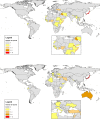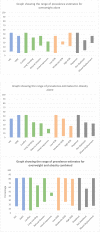A systematic review of the burden of, access to services for and perceptions of patients with overweight and obesity, in humanitarian crisis settings
- PMID: 37093795
- PMCID: PMC10124894
- DOI: 10.1371/journal.pone.0282823
A systematic review of the burden of, access to services for and perceptions of patients with overweight and obesity, in humanitarian crisis settings
Abstract
Introduction: Excess body weight causes 4 million deaths annually across the world. The number of people affected by humanitarian crises stands at a record high level with 1 in 95 people being forcibly displaced. These epidemics overlap. Addressing obesity is a post-acute phase activity in non-communicable disease management in humanitarian settings. Information is needed to inform guidelines and timing of interventions. The objective of this review was to explore the prevalence of overweight and obesity in populations directly affected by humanitarian crises; the cascade of care in these populations and perceptions of patients with overweight and obesity.
Methods: Literature searches were carried out in five databases. Grey literature was identified. The population of interest was non-pregnant, civilian adults who had experience of humanitarian crises (armed conflict, complex emergencies and natural disasters). All study types published from January 1st, 2011, were included. Screening, data extraction and quality appraisal were carried out in duplicate. A narrative synthesis is presented.
Results: Fifty-six reports from forty-five studies were included. Prevalence estimates varied widely across the studies and by subgroups. Estimates of overweight and obesity combined ranged from 6.4% to 82.8%. Studies were heterogenous. Global distribution was skewed. Increasing adiposity was seen over time, in older adults and in women. Only six studies were at low risk of bias. Body mass index was the predominant measure used. There were no studies reporting cascade of care. No qualitative studies were identified.
Conclusion: Overweight and obesity varied in crisis affected populations but were rarely absent. Improved reporting of existing data could provide more accurate estimates. Worsening obesity may be prevented by acting earlier in long-term crises and targeting risk groups. The use of waist circumference would provide useful additional information. Gaps remain in understanding the existing cascade of care. Cultural norms around diet and ideal body size vary.
Copyright: © 2023 Shortland et al. This is an open access article distributed under the terms of the Creative Commons Attribution License, which permits unrestricted use, distribution, and reproduction in any medium, provided the original author and source are credited.
Conflict of interest statement
The authors have declared that no competing interests exist.
Figures




References
-
- Noncommunicable diseases. [cited 20 Jan 2022]. Available: https://www.who.int/news-room/fact-sheets/detail/noncommunicable-diseases
-
- Transforming our world: the 2030 Agenda for Sustainable Development. [cited 20 Jan 2022]. Available: https://sdgs.un.org/2030agenda
Publication types
MeSH terms
Grants and funding
LinkOut - more resources
Full Text Sources

